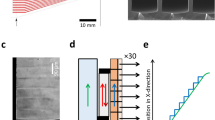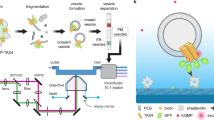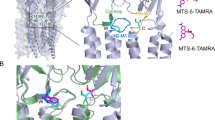Abstract
The accurate knowledge of receptor kinetics is crucial to our understanding of cell signal transduction in general and neural function in particular. The classical technique of probing membrane receptors on a millisecond scale involves placing a recording micropipette with a membrane patch in front of a double-barrel (θ-glass) application pipette mounted on a piezo actuator. Driven by electric pulses, the actuator can rapidly shift the θ-glass pipette tip, thus exposing the target receptors to alternating ligand solutions. However, membrane patches survive for only a few minutes, thus normally restricting such experiments to a single-application protocol. In order to overcome this deficiency, we have introduced pressurized supply microcircuits in the θ-glass channels, thus enabling repeated replacement of application solutions within 10–15 s. This protocol, which has been validated in our recent studies and takes 20–60 min to implement, allows the characterization of ligand-receptor interactions with high sensitivity, thereby also enabling a powerful paired-sample statistical design.
This is a preview of subscription content, access via your institution
Access options
Subscribe to this journal
Receive 12 print issues and online access
$259.00 per year
only $21.58 per issue
Buy this article
- Purchase on Springer Link
- Instant access to full article PDF
Prices may be subject to local taxes which are calculated during checkout





Similar content being viewed by others
References
Clements, J.D., Lester, R.A., Tong, G., Jahr, C.E. & Westbrook, G.L. The time course of glutamate in the synaptic cleft. Science 258, 1498–1501 (1992).
Lisman, J.E., Raghavachari, S. & Tsien, R.W. The sequence of events that underlie quantal transmission at central glutamatergic synapses. Nat. Rev. Neurosci. 8, 597–609 (2007).
Zheng, K., Scimemi, A. & Rusakov, D.A. Receptor actions of synaptically released glutamate: the role of transporters on the scale from nanometers to microns. Biophys. J. 95, 4584–4596 (2008).
Krishtal, O.A. & Pidoplichko, V.I. A receptor for protons in the nerve cell membrane. Neuroscience. 5, 2325–2327 (1980).
Franke, C., Hatt, H. & Dudel, J. Liquid filament switch for ultra-fast exchanges of solutions at excised patches of synaptic membrane of crayfish muscle. Neurosci. Lett. 77, 199–204 (1987).
Raman, I.M. & Trussell, L.O. The kinetics of the response to glutamate and kainate in neurons of the avian cochlear nucleus. Neuron 9, 173–186 (1992).
Albuquerque, E.X. et al. Functional properties of the nicotinic and glutamatergic receptors. J. Recept. Res. 11, 603–625 (1991).
Brett, R.S., Dilger, J.P., Adams, P.R. & Lancaster, B. A method for the rapid exchange of solutions bathing excised membrane patches. Biophys. J. 50, 987–992 (1986).
Lester, R.A.J. & Jahr, C.E. NMDA channel behavior depends on agonist affinity. J. Neurosci. 12, 635–643 (1992).
Tong, G. & Jahr, C.E. Multivesicular release from excitatory synapses of cultured hippocampal-neurons. Neuron 12, 51–59 (1994).
Raman, I.M., Zhang, S. & Trussell, L.O. Pathway-specific variants of AMPA receptors and their contribution to neuronal signaling. J. Neurosci. 14, 4998–5010 (1994).
Colquhoun, D., Jonas, P. & Sakmann, B. Action of brief pulses of glutamate on AMPA/kainate receptors in patches from different neurones of rat hippocampal slices. J. Physiol. 458, 261–287 (1992).
Spruston, N., Jonas, P. & Sakmann, B. Dendritic glutamate-receptor channels in rat hippocampal CA3 and CA1 pyramidal neurons. J. Physiol. 482, 325–352 (1995).
Sachs, F. Practical limits on the maximal speed of solution exchange for patch-clamp experiments. Biophys. J. 77, 682–690 (1999).
Veselovsky, N.S., Engert, F. & Lux, H.D. Fast local superfusion technique. Pflugers Arch. 432, 351–354 (1996).
Niu, L. et al. Rapid chemical kinetic techniques for investigations of neurotransmitter receptors expressed in Xenopus oocytes. Proc. Natl. Acad. Sci. USA 93, 12964–12968 (1996).
Maconochie, D.J. & Knight, D.E. A method for making solution changes in the sub-millisecond range at the tip of a patch pipette. Pflugers Arch. 414, 589–596 (1989).
Savtchenko, L.P., Sylantyev, S. & Rusakov, D.A. Central synapses release a resource-efficient amount of glutamate. Nat. Neurosci. 16, 10–12 (2013).
Sylantyev, S. et al. Electric fields due to synaptic currents sharpen excitatory transmission. Science 319, 1845–1849 (2008).
Sylantyev, S., Savtchenko, L.P., Ermolyuk, Y., Michaluk, P. & Rusakov, D.A. Spike-driven glutamate electrodiffusion triggers synaptic potentiation via a Homer-dependent mGluR-NMDAR link. Neuron 77, 528–541 (2013).
Wlodarczyk, A.I. et al. GABA-independent GABAA receptor openings maintain tonic currents. J. Neurosci. 33, 3905–3914 (2013).
Marty, A. & Neher, E. Tight-seal whole-cell recording. In Single-Channel Recording (eds. Sakmann, B. & Neher, E.) 31–52 (Springer, 2009).
Molleman, A Patch Clamping: An Introductory Guide To Patch-Clamp Electrophysiology (J. Wiley & Sons, 2003).
Penner, R. A practical guide to patch clamping. in Single-Channel Recording (eds. Sakmann, B. & Neher, E.) 3–30 (Springer, 2009).
Hamill, O.P., Marty, A., Neher, E., Sakmann, B. & Sigworth, F.J. Improved patch-clamp techniques for high-resolution current recording from cells and cell-free membrane patches. Pflugers Arch. 391, 85–100 (1981).
Brown, J., Hainsworth, A., Stefani, A. & Randall, A. Whole-cell patch-clamp recording of voltage-sensitive Ca2+ channel currents in single cells: heterologous expression systems and neurones. in Calcium Signaling Protocols (eds. Lambert, D.G. & Rainbow, R.D.) 123–148 (Humana Press, 2013).
Acknowledgements
This work was supported by the Wellcome Trust, Medical Research Council (UK), the European Research Council (Advanced Grant), the European Commission COST Action BM1001 ECMNet, and the Biology and Biotechnology Research Council (UK).
Author information
Authors and Affiliations
Contributions
S.S. carried out the experimental studies; D.A.R. and S.S. designed the protocol, analyzed the data and wrote the paper.
Corresponding authors
Ethics declarations
Competing interests
The authors declare no competing financial interests.
Supplementary information
Calibration of the rapid solution application pipette with an open patch electrode.
The recording (Video 1) starts with the right and left θ-glass pipette channels ejecting distilled water and ACSF, respectively. The stream boundaries and the interface can be seen as image (phase) contrast. Solutions are swapped at three time points (min: sec): 1:11, 1:50 and 2:34. Starting from the 2:34 time point both channels eject ACSF (yielding an invisible interface and boundaries). Note that because of a reclined position of the pipette holder (Fig. 2c) the θ-glass pipette tip is out of focus when the recording pipette tip is in focus. The piezo-driven θ-glass pipette movements are not visible because they are too fast (∼150-200 μs) to be captured using the standard 24 frames per second rate of video recording. (AVI 5411 kb)
Preparing an outside-out patch for the RASE protocol.
The pulling of an outside-out patch and transferring the patch pipette to the optimised XYZ position of the tip, as determined during the preceding calibration procedure. An acute cerebellar slice experiment, see 20 for details. (AVI 12629 kb)
The RASE protocol applied to the nucleated patch pulled from the same cell as an outside-out patch.
The pulling of a nucleated patch from the same cell as that used in Supplementary Video 2, also depicting pipette positioning and the beginning of ligand application. An acute cerebellar slice experiment, see 20 for details. (AVI 17558 kb)
Rights and permissions
About this article
Cite this article
Sylantyev, S., Rusakov, D. Sub-millisecond ligand probing of cell receptors with multiple solution exchange. Nat Protoc 8, 1299–1306 (2013). https://doi.org/10.1038/nprot.2013.075
Published:
Issue Date:
DOI: https://doi.org/10.1038/nprot.2013.075
This article is cited by
-
Fast functional mapping of ligand-gated ion channels
Communications Biology (2023)
-
Multi-target action of β-alanine protects cerebellar tissue from ischemic damage
Cell Death & Disease (2022)
-
Monitoring cell membrane recycling dynamics of proteins using whole-cell fluorescence recovery after photobleaching of pH-sensitive genetic tags
Nature Protocols (2022)
-
The regulatory role of GABAA receptor in Actinia equina nervous system and the possible effect of global ocean acidification
Pflügers Archiv - European Journal of Physiology (2021)
-
Spontaneously opening GABAA receptors play a significant role in neuronal signal filtering and integration
Cell Death & Disease (2018)
Comments
By submitting a comment you agree to abide by our Terms and Community Guidelines. If you find something abusive or that does not comply with our terms or guidelines please flag it as inappropriate.



